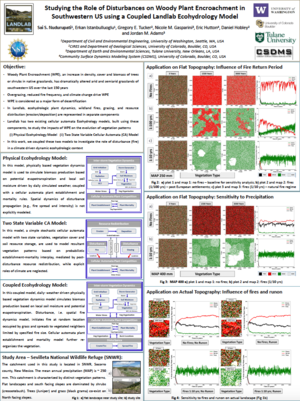Annualmeeting:2017 CSDMS meeting-019
Browse abstracts
Studying the Role of Disturbances on Woody Plant Encroachment in Southwestern US using a Coupled Landlab Ecohydrology Model

Woody Plant Encroachment (WPE), an increase in density, cover and biomass of trees or shrubs in native grasslands, has been observed to be a major cause for dramatic changes in arid and semiarid grasslands of southwestern US over the last 150 years. Driven by overgrazing, reduced fire frequency, and climate change, WPE is considered as a major form of desertification. In Landlab, ecohydrologic plant dynamics, wildland fires, grazing, and resource distribution (erosion/deposition) are represented in separate components. Landlab has two existing cellular automata Ecohydrology models, built using these components, to study the impacts of WPE on the evolution of vegetation patterns. In the first model, physically based vegetation dynamics model is used to simulate biomass production based on local soil moisture and potential evapotranspiration driven by daily simulated weather, coupled with a cellular automata plant establishment and mortality rules. In this model, spatial dynamics of disturbance propagation (e.g., fire spread and intensity) is not explicitly modeled. In the second model, a simple stochastic cellular automata model with two state variables, vegetation cover and soil resource storage, are used to model resultant vegetation patterns based on probabilistic establishment-mortality interplay, mediated by post-disturbance resource redistribution, while explicit roles of climate are neglected. In this work, we coupled these two models to investigate the role of disturbances (fire and grazing) in a climate driven dynamic ecohydrologic context. In this coupled model, daily- weather driven physically based vegetation dynamics model is coupled with cellular automata plant establishment model that explicitly simulates spatial disturbance dynamics. The effects of encroachment factors and model complexity on resultant vegetation patterns are studied.
